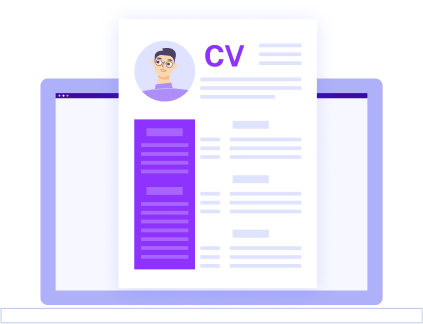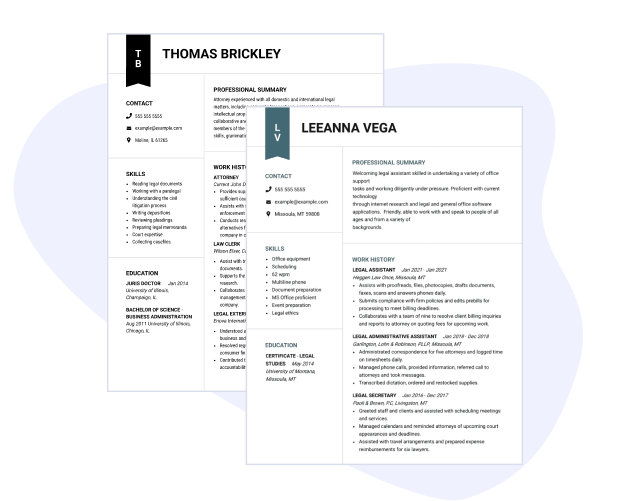We personalize your experience.
We use cookies in our website to ensure we give you the best experience, get to know our users and deliver better marketing. For this purpose, we may share the information collected with third parties. By clicking “Allow cookies” you give us your consent to use all cookies. If you prefer to manage your cookies click on the “Manage cookies” link below.
Need to write a CV? CV examples can be a major help. Use these top CV examples combined with ResumeHelp’s CV Builder to create an even more effective curriculum vitae.
Our customers have been hired by*:*Foot Note

These CV samples focus on academic achievements, projects and related recognitions.
These CVs stress professional achievements and recognitions as well as academic excellence.
A CV and a resume are both documents that provide an overview of your career and show how you’re qualified for the job being applied for. A CV provides an extensive view of your academic and professional background, while a resume highlights relevant qualifications, skills and work experience.
Finding the right CV example can make the process of creating your own quick and easy. Review our vast catalog of CV samples to find the one that fits your future career.
These CV examples show you how you can create a CV that highlights job seekers’ relevant educational history, as well as key soft skills.
Check out our business CV examples to learn how to organize your work experience, core qualifications and education.
It’s crucial to review important caretaker CV samples before writing your own. These expert-created CVs show you how to display critical skills that can help you land a coveted job as a nanny.
Take your career to the next level with a CV that highlights your creativity and technical skills. You can quickly write and format a well-designed CV for hot positions, such as graphic designer, using the ResumeHelp CV Maker.
These CV examples showcase subject expertise and how the job applicant can make an active difference in students’ lives — elements that should make it into your teacher curriculum vitae.
Having a strong medical CV is important to achieve your goals in medicine. Our health care CV examples will provide you with the right guidance on how to effectively present your education, past experience and skill set.
Whether you want to become an attorney or are applying for law school, you should take the time to look at our legal CV examples to see the best ways to highlight your credentials.
Administrative assistants and the team that keeps an office running are key to a company's success. Ensure you hit all the right marks in your curriculum vitae by following our office support CV samples.
Are you in a less traditional industry? Check out our other CV samples! You’re bound to find the right example CVs to fit your industry.
If you work in law enforcement or are an emergency response professional, you’ll need a curriculum vitae that adequately represents your skills and qualifications. Review our sample CVs specific to your job to get an idea of the best layouts and format to use.
Showcase your excellent communication skills, negotiation skills and interpersonal skills with the help of our professional sales CV examples. Our samples will show you how to highlight important sales skills, such as sales management, B2B sales and persuasion.
Many jobs require highly technical skills that aren’t easily learned but are in high demand. Use our CV examples as a foundation for your curriculum vitae. We can help you present your technical knowledge, abilities and relevant technical expertise.

It’s important to create and format a CV that will pass applicant tracking systems (ATS) and make a good impression on hiring managers. Just use our CV examples and CV Builder, along with the tips below.
We’ve got over a dozen different designs you can pick from. Then create a new CV from scratch or upload an existing CV into the template.
The builder will automatically guide you through creating your summary, work history, skills and education sections.
Use our spell check tools to eliminate grammatical errors and typos. When ready, save your finished CV in MS Word, text or PDF formats. If you don’t want to download your CV just yet, you can always save your work and return to it later.

The CV examples on this page are just a few of the many you’ll find on our site, covering every major job title. Use these CV samples to create the perfect CV for any job application.
If you’re looking to improve your CVs “design,” check out our CV templates. These layouts will ensure a standout CV that gets you your dream job, even if you’re a recent graduate.
Reading through our CV examples is your chance to review your work history and professional achievements, comparing them to what hiring managers are looking for. Take the time to figure out your goals, what you want the next step of your career to look like and how that fits with what a potential employer is looking for.
A CV features both your work and educational history, so make sure to feature relevant qualifications for both. Don’t just restrict these details to your work history and education sections either. Your summary and core skills sections will benefit if you can display important professional and academic achievements.
Break down your most important projects and accomplishments, and find ways to sum up what you’ve accomplished. Do some self-analysis and group together your best hard and soft skills to find the industry that’s right for you.
Look through the job advertisement to pick out keywords that define what the specific job needs and incorporate them in your own CV. For example, if the job description lists technical skills such as “project management,” you should list any skills you have with project management tools or feature a work achievement that demonstrates your abilities. For more on how to get the most out of keywords in your CV or resume, check out our keyword tips.
A CV also has room to feature sections for educational qualifications such as awards and significant research highlights, not to mention publications and presentations. Take advantage of sections like these to present a comprehensive picture of your abilities.
Your CV is the perfect place to show how connected you are to your industry and skills development outside and inside the workplace. Your personal projects and volunteer work can provide needed insights, and show off significant technical skills and soft skills in ways a standard resume doesn’t.
Impressive details always read better than just plain information. Instead of listing everyday tasks, focus on major professional achievements. If you’re a professor, don’t just say you taught a class; explain how you’ve made a difference. For example: “Developed and taught a new Asian studies curriculum to 200 students each semester.”
Because CVs are longer chronicles of your career history you need to pay close attention to how you order your sections. Structure your document with this “top-down” approach:
Feature your professional summary and goals at the top, followed by a Summary of Qualifications and core skills, then list your work experience, academic projects and research in reverse-chronological order by significance on the following pages. For more tips on your CV format and how to lay out your CV, visit our CV formats page.
To just write a CV isn’t the whole story — you should also show you’re involved and committed to your field and desired job. It’s important to have a bank of references to choose from. Your affiliations, conferences, professorships and academic assistance can foster credibility and industry expertise. For more on how to create the right network to elevate your career, see our networking tips.
When you need to create a great CV, start with ResumeHelp’s CV examples. These samples have been created to help job candidates land dream jobs.
Your CV should not only impress the prospective employer with your best qualifications, but also present them in a polished layout. Our example of a good CV will provide you with an easy-to-read format, so you’ll know exactly how to write and organize your own curriculum vitae.
When we say our samples are “employer-ready,” we’re serious. Our experts have assembled content on a wide range of job titles and industries, and our examples are packed with qualifications and work history that exemplify a top-notch candidate for the position. Whether you’re looking for construction CV examples that demonstrate the important hard skills needed for the position, or nurse CV templates that put the spotlight on abilities key for caring for patients, we’ve got you covered.
When it comes to CVs, hiring managers and the applicant tracking system (ATS) they use will be looking for specific qualifications in the form of keywords matching job requirements. Any example of a good CV on our site will cue you into the important skills and qualifications you should include in your CV, which also happens to be the keywords that will help you pass ATS. Our samples can also be customized to best fit what’s needed for the specific job.

Check out our CV Builder to find resume samples, tips and other relevant information to create your own resume or CV. We’ll make sure you have the right words and job-specific qualifications that hiring managers want.
Have questions? We’re here to help.
CV stands for curriculum vitae, which is Latin for “course of life.” It’s an in-depth document that goes over all your work history, prominently including your teaching experience, fellowships, memberships, research experience, affiliations, educational background and other academic achievements. This can also include mentoring and conference work. It is a document that’s usually created if you’re applying for an academic job in the United States or Canada.
In many other countries, including most of Europe, Canada, Australia and Africa, a “CV” is more similar to an American resume and is requested for every position in a job application. It is commonly a two-page document that goes over your experience and skills, and depending on the region could require more supplementary information.
For example, CVs in other countries may require more detail. A UK CV includes the date and place of birth, gender, marital status, ID number, driving license information and even your health information. A credible references section may also be requested so that your potential employer can check on how you performed in previous positions.
This differentiation means that some hiring managers in the United States, especially ones that are used to working for international companies, may ask you for a “CV” when they mean a resume. If you’re ever unsure if a company is asking for a CV or a resume, ask for clarification.
A CV example is a completed CV that gives you a guide for what to include in your own CV. CV examples for specific positions provide insight on the types of skills and experiences hiring managers are looking for, as well as a “frame” you can follow when filling out a CV with your own content, using a CV Builder. The best CV examples are those written by career professionals who understand the specifics of the occupation the examples are being created for.
How to write a C is similar to how to write a good resume:
Couldn't find the answer you're looking for?